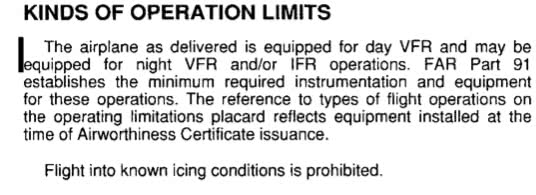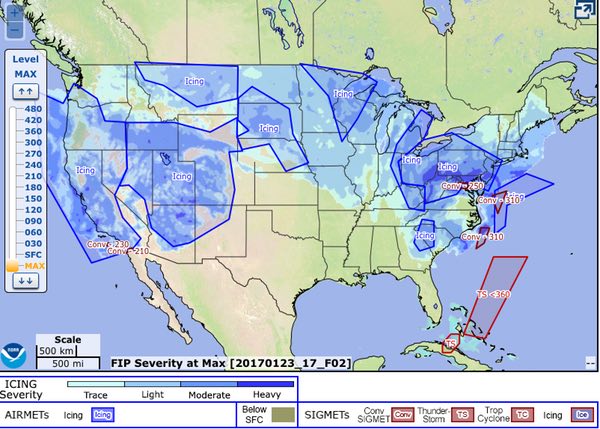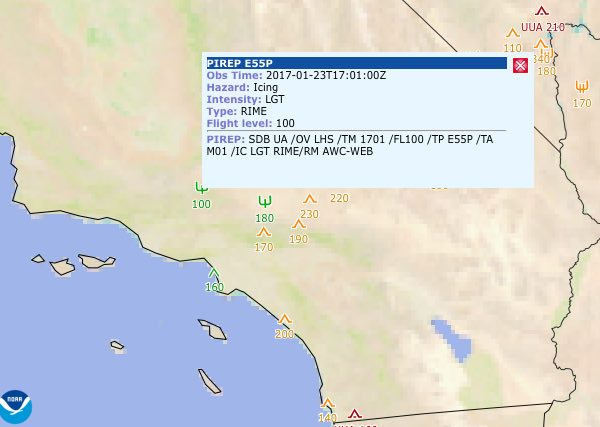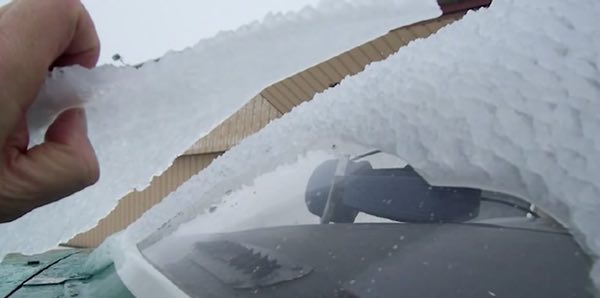Icing
Icing can occur any time there is visible moisture and the temperature is between +02 and −10 degrees Celsius. As shown in the videos, icing can accumulate gradually or suddenly, with catastrophic effects. The FAA has put out a lot of information on icing—including an entire chapter in AC 00-6b Aviation Weather. The WINGS program has several courses on icing as well. The FARs address it, and the Aviation Weather Center provides icing forecasts. There is also lots of information on icing, including training videos and quizzes at the AOPA Air Safety Institute.
AIM Section 7 Weather
In the CONUS, SIGMETs are issued when the following phenomena occur or are expected to occur: (a) Severe icing not associated with thunderstorms.
Any convective SIGMET implies severe or greater turbulence, severe icing, and low−level wind shear. A convective SIGMET may be issued for any convective situation that the forecaster feels is hazardous to all categories of aircraft.
AIRMET Zulu describes moderate icing and provides freezing level heights.
A clear radar display (no echoes) does not mean that there is no significant weather within the coverage of the radar site. Clouds and fog are not detected by the radar. However, when echoes are present, turbulence can be implied by the intensity of the precipitation, and icing is implied by the presence of the precipitation at temperatures at or below zero degrees Celsius.
PIREPs Relating to Airframe Icing
The effects of ice on aircraft are cumulative-thrust is reduced, drag increases, lift lessens, and weight increases. The results are an increase in stall speed and a deterioration of aircraft performance. In extreme cases, 2 to 3 inches of ice can form on the leading edge of the airfoil in less than 5 minutes. It takes but 1/2 inch of ice to reduce the lifting power of some aircraft by 50 percent and increases the frictional drag by an equal percentage.
A pilot can expect icing when flying in visible precipitation, such as rain or cloud droplets, and the temperature is between +02 and −10 degrees Celsius. When icing is detected, a pilot should do one of two things, particularly if the aircraft is not equipped with deicing equipment; get out of the area of precipitation; or go to an altitude where the temperature is above freezing. This “warmer” altitude may not always be a lower altitude. Proper preflight action includes obtaining information on the freezing level and the above freezing levels in precipitation areas. Report icing to ATC, and if operating IFR, request new routing or altitude if icing will be a hazard. Be sure to give the type of aircraft to ATC when reporting icing. The following describes how to report icing conditions.
1. Trace. Ice becomes perceptible. Rate of accumulation slightly greater than sublimation. Deicing/anti-icing equipment is not utilized unless encountered for an extended period of time (over 1 hour).
2. Light. The rate of accumulation may create a problem if flight is prolonged in this environment (over 1 hour). Occasional use of deicing/anti-icing equipment removes/prevents accumulation. It does not present a problem if the deicing/anti-icing equipment is used.
3. Moderate. The rate of accumulation is such that even short encounters become potentially hazardous and use of deicing/anti-icing equipment or flight diversion is necessary.
4. Severe. The rate of accumulation is such that ice protection systems fail to remove the accumulation of ice, or ice accumulates in locations not normally prone to icing, such as areas aft of protected surfaces and any other areas identified by the manufacturer. Immediate exit from the condition is necessary.
Types of Icing
Rime ice. Rough, milky, opaque ice formed by the instantaneous freezing of small supercooled water droplets. The rapid freezing results in air being trapped, giving the ice its opaque appearance and making it porous and brittle. Rime ice typically accretes along the stagnation line of an airfoil and is more regular in shape and conformal to the airfoil than glaze ice.
Clear ice. A glossy, clear, or translucent ice formed by the relatively slow freezing of large supercooled water droplets. With larger accretions, the ice shape typically includes “horns” protruding from unprotected leading edge surfaces.
Mixed. A combination of rime and clear ice.
It is the ice shape, rather than the clarity or color of the ice, which is most likely to be accurately assessed from the cockpit.
Operators of large turbine aircraft have regulations related to icing and it would behoove operators of GA airplanes to follow the same rules, except substitute forecast or known icing for forecast light or moderate icing
§91.527 Operating in icing conditions.
(a) No pilot may take off an airplane that has frost, ice, or snow adhering to any propeller, windshield, stabilizing or control surface; to a powerplant installation; or to an airspeed, altimeter, rate of climb, or flight attitude instrument system or wing, except that takeoffs may be made with frost under the wing in the area of the fuel tanks if authorized by the FAA.
(b) No pilot may fly under IFR into known or forecast light or moderate icing conditions, or under VFR into known light or moderate icing conditions, unless—
(1) The aircraft has functioning deicing or anti-icing equipment protecting each rotor blade, propeller, windshield, wing, stabilizing or control surface, and each airspeed, altimeter, rate of climb, or flight attitude instrument system;
(2) The airplane has ice protection provisions that meet section 34 of Special Federal Aviation Regulation No. 23; or
(3) The airplane meets transport category airplane type certification provisions, including the requirements for certification for flight in icing conditions.
(c) Except for an airplane that has ice protection provisions that meet the requirements in section 34 of Special Federal Aviation Regulation No. 23, or those for transport category airplane type certification, no pilot may fly an airplane into known or forecast severe icing conditions.
(d) If current weather reports and briefing information relied upon by the pilot in command indicate that the forecast icing conditions that would otherwise prohibit the flight will not be encountered during the flight because of changed weather conditions since the forecast, the restrictions in paragraphs (b) and (c) of this section based on forecast conditions do not apply.
Pilots Handbook of Aeronautical Knowledge
For example, if ice, snow, and frost are allowed to accumulate on the surface of an aircraft, the smooth airflow over the wing is disrupted. This causes the boundary layer to separate at an AOA lower than that of the critical angle. Lift is greatly reduced, altering expected aircraft performance. If ice is allowed to accumulate on the aircraft during flight, the weight of the aircraft is increased while the ability to generate lift is decreased. As little as 0.8 millimeter (1/32 inch) of ice on the upper wing surface increases drag and reduces aircraft lift by 25 percent.
Frost disrupts the flow of air over the wing and can drastically reduce the production of lift. It also increases drag, which when combined with lowered lift production, can adversely affect the ability to take off. An aircraft must be thoroughly cleaned and free of frost prior to beginning a flight.
Instrument Flying Handbook
In extreme cases, two to three inches of ice can form on the leading edge of the airfoil in less than 5 minutes. It takes only 1⁄2 inch of ice to reduce the lifting power of some aircraft by 50 percent and increases the frictional drag by an equal percentage.
Airplane Flying Handbook
Ice accumulates unevenly on the airplane. It adds weight and drag (primarily drag) and decreases thrust and lift. Even wing shape affects ice accumulation; thin airfoil sections are more prone to ice accumulation than thick, highly- cambered sections. For this reason, certain surfaces, such as the horizontal stabilizer, are more prone to icing than the wing. With ice accumulations, landing approaches should be made with a minimum wing flap setting (flap extension increases the AOA of the horizontal stabilizer) and with an added margin of airspeed. Sudden and large configuration and airspeed changes should be avoided.
Unless otherwise recommended in the AFM/POH, the autopilot should not be used in icing conditions. Continuous use of the autopilot masks trim and handling changes that occur with ice accumulation. Without this control feedback, the pilot may not be aware of ice accumulation building to hazardous levels. The autopilot suddenly disconnects when it reaches design limits, and the pilot may find the airplane has assumed unsatisfactory handling characteristics.
Advisory Circular AC 135-17
Test data indicate that ice, snow, or frost formations having thickness and surface roughness similar to medium or course sandpaper on the leading edge and upper surfaces of a wing can reduce wing lift by as much as 30 percent and increase drag by 40 percent.
Changes in lift and drag significantly increase stall speed, reduce controllability, and alter aircraft flight characteristics. Thicker or rougher frozen contaminants can have increasing adverse effects on lift, drag, stall speed, stability and control, and aircraft performance with the primary influence being surface roughness located on critical portions of an aerodynamic surface. These adverse effects on the aerodynamic properties of the airfoil may result in sudden departure from the commanded flight path and may not be preceded by or aerodynamic warning to the pilot.
AOPA Aircraft De-icing and Anti-Icing Systems
This Safety Advisor explains the differences and highlights some new systems that are being tested for light aircraft. It also points out that on light GA aircraft, the systems are non-hazard systems that are designed to get you out of icing conditions and not FIKI—designed for flight into known icing conditions.
And as the description implies, anti-icing systems are designed to prevent ice formation. Some anti-icing systems on GA aircraft are weeping wings (TKS systems are an example), heated pitot tubes, and heated windshield plates. The most common de-icing system on GA aircraft is flexible rubber-like boots that expand and contract on ice-prone areas of the aircraft.
Aircraft Certification
Small GA aircraft are not certified for flight into known icing conditions and newer AFMs explicitly state this in their limitations section. Planes produced before standardized AFMs usually do not mention this limitation, but it still applies.

Icing Forecast
You can view icing forecasts at the NOAA Aviation Weather Center site. Click on the icing tab at the top of the image. Use the slider at the side of the image to adjust the altitude and the slider at the top to adjust the forecast period.

Pireps
You can view icing pireps at the NOAA Aviation Weather Center site. EFBs like ForeFlight can be configured to display pireps. Icing looks like a trident. Remember to check the type of aircraft since light icing in an airliner might be considered moderate or severe in a Cessna 172.

Knowledge Test Questions
Which conditions result in the formation of frost?
The temperature of the collecting surface is at or below the dewpoint of the adjacent air and the dewpoint is below freezing.
Why is frost considered hazardous to flight?
Frost spoils the smooth flow of air over the wings, thereby decreasing lifting capability.
Test data indicate that ice, snow, or frost having a thickness and roughness similar to medium or coarse sandpaper on the leading edge and upper surface of an airfoil can:
reduce lift by as much as 30 percent and increase drag by 40 percent.
(IFR Sample Test November 29, 2016) A generally recommended practice for autopilot usage during cruise flight in icing conditions is
A) keeping the autopilot engaged while monitoring the system.
B) periodically disengaging the auto pilot and hand flying the airplane.
C) periodically disengaging and immediately reengaging the altitude hold function.
Like a lot of Knowledge Test questions, none of these answers is correct, if you believe the information in the rest of this post. However, B appears to be least incorrect. It would be correct if they left out the word ‘periodically’. If you are going to use the autopilot, it seems to me that using the autopilot to maintain heading and wings level but disengaging the altitude hold function would give you the most information on whether the icing is affecting aircraft performance.
Icing for General Aviation Pilots
Ice Induced Stall Pilot Training
Real Pilot Story: Ambushed by Ice
A Cessna 182 pilot that survived an encounter with severe icing.

Tip: If you encounter sudden severe icing turn the autopilot off, carb heat on, and ask for lower.
Tip: Have approach charts for airports on your route handy. But if you don’t ATC can help you out.
Tip: Leave flaps up for landing.
Factoid: Airframe ice brings down about a quarter of all GA airplanes lost to weather.
Real Pilot Story: Ambushed by Ice
Accident Case Study: Airframe Icing
The pilot of a Cirrus SR22 encountered unforecast icing over the Sierra Nevada mountains.
Tip: If you start picking up ice, let ATC know and get out of it immediately.
Real Pilot Story: Icing Encounter
Icing for General Aviation Pilots
How to de-ice an airplane


